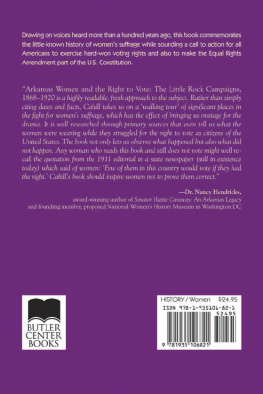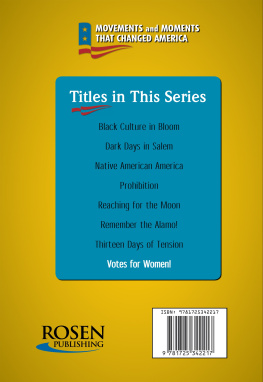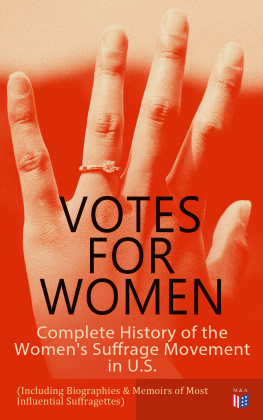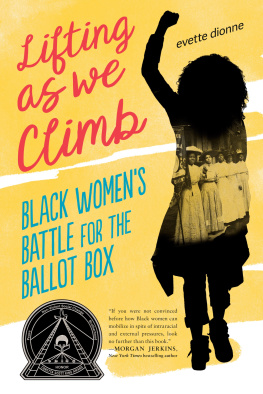
Also by BERNADETTE CAHILL
Alice Paul, the National Womans Party and the Vote:
The First Civil Rights Struggle of the 20th Century
(McFarland, 2015)
No Vote for Women
The Denial of Suffrage in Reconstruction America
Bernadette Cahill

McFarland & Company, Inc., Publishers
Jefferson, North Carolina
LIBRARY OF CONGRESS CATALOGUING DATA ARE AVAILABLE
BRITISH LIBRARY CATALOGUING DATA ARE AVAILABLE
e-ISBN: 978-1-4766-3594-1
2019 Bernadette Cahill. All rights reserved
No part of this book may be reproduced or transmitted in any form or by any means, electronic or mechanical, including photocopying or recording, or by any information storage and retrieval system, without permission in writing from the publisher.
Front cover: Elizabeth Cady Stanton (left) and Susan B. Anthony, photograph by Napoleon Sarony, circa 1870 (National Portrait Gallery)
McFarland & Company, Inc., Publishers
Box 611, Jefferson, North Carolina 28640
www.mcfarlandpub.com
For all those who fought so valiantly
for equal rights for all during Reconstruction
and were virulently attacked for doing so
Acknowledgments
This work has taken me six years, during which time my husband, Ron Davis, has helped me learn to walk again after I suffered a smashed leg and supported me when I had cancer and other difficulties. I have received terrific support from my sister, Dr. Catherine Smith, of Stirling, Scotland, and her husband, Cairns Mason. My husbands grandson, Trey Davis; my friend Kay Bennett of Vicksburg, Mississippi, who regularly drove me 80 miles and back for chemo treatments; my friend Becky Conley of Monroe, Louisiana; and Gloria and Mick Watts of Romance, Arkansas, also supported me wonderfully, as did an array of other friends and angels in the healing community who rallied around.
On a professional level there were many librarians at the following who helped me pin down particular documents: the LIBRARY OF CONGRESS; the libraries in Little Rock, Alysanne Crymes of the Butler Center in particular; and Lesa Foster of the Vicksburg, Mississippi, library. I must also thank Hannah Weinberg and the archivists of the research services of the Schlesinger Library, Radcliffe Institute, Harvard University, Cambridge, Massachusetts, for locatingand making readable while dealing with upheavala source that turned out to be critical to the solution of a mystery and for providing everything I needed for its inclusion in this book. Finally, I thank all the historians before me, from the writers of the History of Woman Suffrage on, who uncovered facts, told their tales, made me hunt answers to questions, and pointed the way.
We are all building a monument to the history of women. This book is yet another contribution to its construction.
Introduction
This book tells of the first political campaigns to win votes for women in the United States, which took place during Reconstruction. They resulted in womens resounding defeat by a Congress intent on having male suffrage onlyRepublicans specifically, who aimed to cement their hold after the Civil War and secure military, political, social, and economic victory over the southern slave power. Based on their reform history, Republicans should have supported equal rights for all, but agitators and the Republican Party latched onto a male-only agenda, peddling the reforms they advocated both as antislavery after abolition and as race equality. Based on their slave history, Democrats acted as expected, opposing voting rights for black males. They generally also opposed women until a small number switched sides, some perhaps out of justice but others to undermine the Republicans and even others to try to resist, subvert, or compensate for black male voting rights. This book is the story of how this happened during a vicious period in American history, a period in which in most treatmentssome monographs specifically about women are the exceptionwomen largely appear in a few paragraphs. It reinterprets Reconstruction from a female civil rights perspective, relating how Reconstruction politicians built a massive bulwark against equality in the United States, even as many professed they were for equality. In this perspective, neither political party emerges as praiseworthy. Neither political party should be proud of this history. Only those women and reformers who led the struggle, some other individuals, Congressmen, and around 9,000 male voters with mixed motives could hold their heads high over these events.
Yet this is history. It is about people and events in the past. Attitudes and laws have evolved and changed since then, through womens own monumental struggles specifically for the votewon by an amendment to the United States Constitution in 1920 that wiped out some of the effects of the Reconstruction word male in that document. The contrast between then and now is startling. The only thing regrettable is that knowledge of what used to be is largely ignored and forgotten, so that many consider perennial the situation that pertains today. Unfortunately, lack of knowledge also allows the notion to take hold that nothing has changed, that reform today requires the same supreme effort demanded of women more than 150 years ago and that men are as blinkered as they were then. This story might help to change these false impressions and any actions based on them. Nevertheless, as of this writing, women in the United States still do not have equal rights in fundamental law, for the Equal Rights Amendment, introduced in 1923, still awaits full ratification. However, since my first book about the vote, Alice Paul, the National Womans Party and the Vote: The First Civil Rights Struggle of the 20th Century (McFarland, 2015), two more states have ratified it, leaving the field open for one state to assume in American history the honored position of taking the ERA over the finish lineto face a final, likely contentious hurdle in Congress that no other amendment has had to deal with.
This book, therefore, relates the womens postCivil War story nationally, in New York State, and in Kansas. It continues to the aftermath for women of the Reconstruction amendments through judicial decision. It pays close attention to the time line, weaving national, state, and reform politics together with the womens work for true equality. Epigraphs in chapters throughout the book give voice to those in favor of womans suffrage and those opposed to it. A concluding series of epigraphs speaks to the devastation of defeat.
The book corrects some time-honored mythsabout events as the women remembered them in New York in 1867; about Susan B. Anthonys contentious role in Kansas that same year; about some of the reforming saints of Reconstruction; and about the truth of the Reconstruction agenda and its devastating impact. The time line has never been accorded such detail before, and the dynamic of its separate strands makes comprehensible for the first time the evolving attitudes of the leading women, challenging historys verdict on them and their colleagues.
Throughout the book the terms womans suffrage, female suffrage, and womans rights are used unless womens appeared in a quote or title, in which case it was not changed. Woman was used by the women of the time for their organizations and for the title of the History. Female suffrage was the Kansas usage.
Next page










